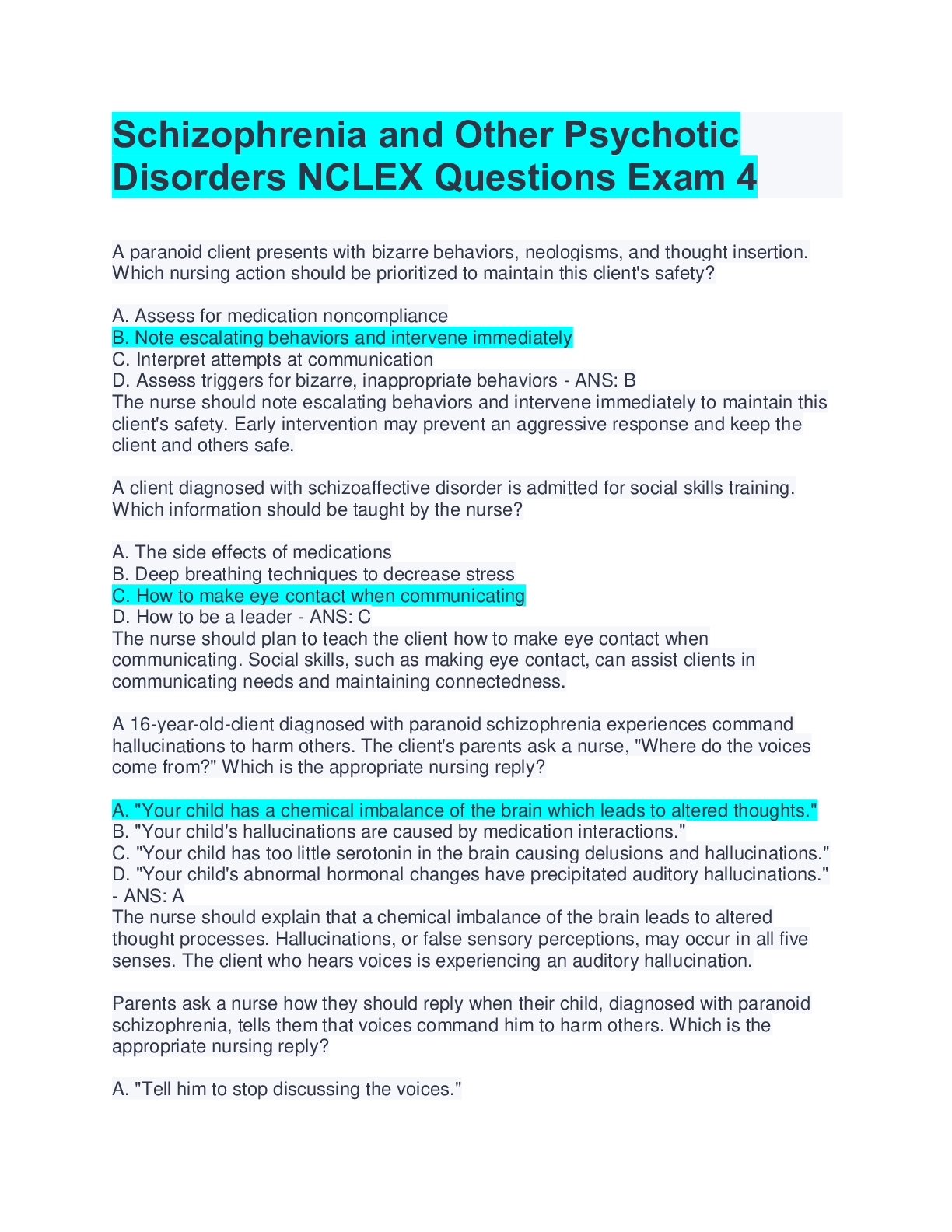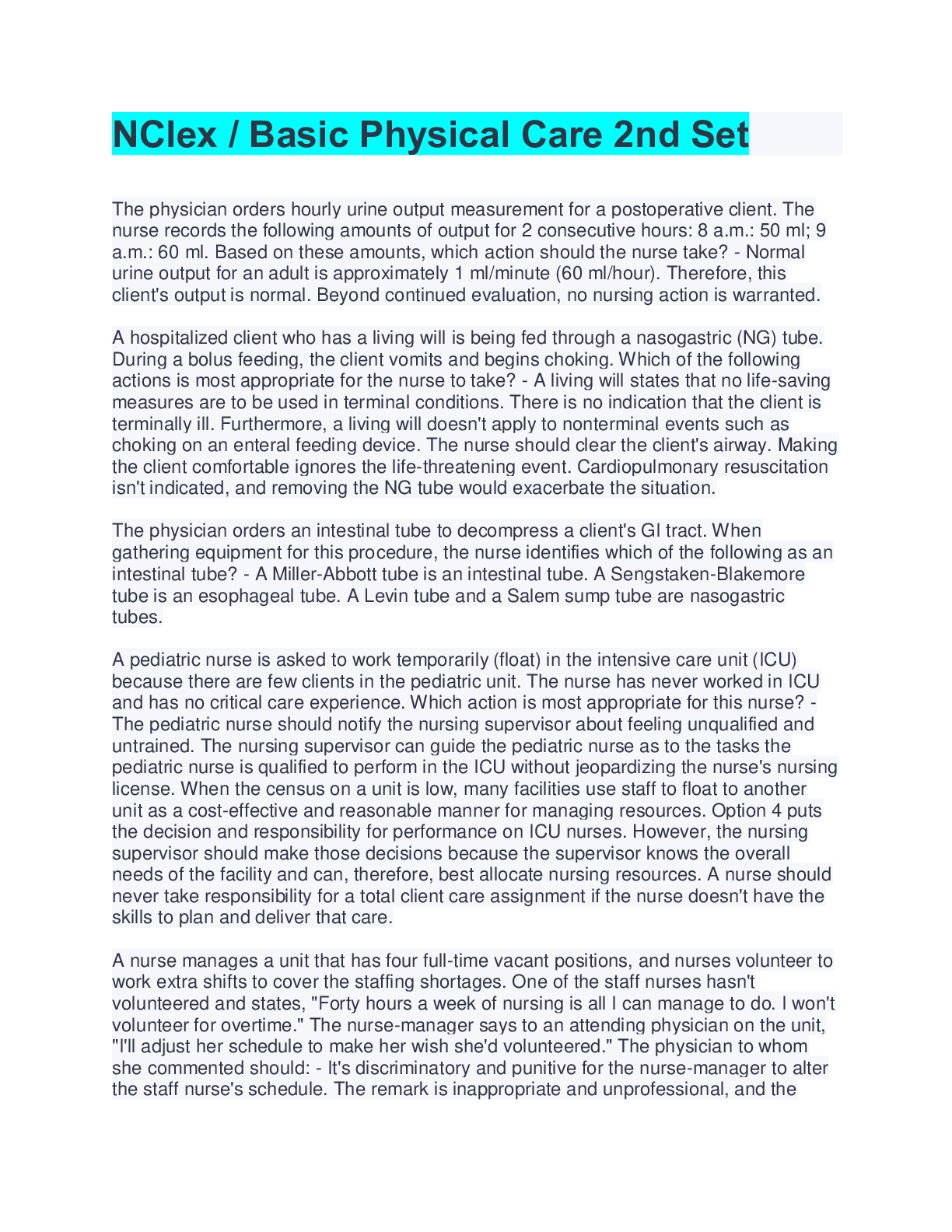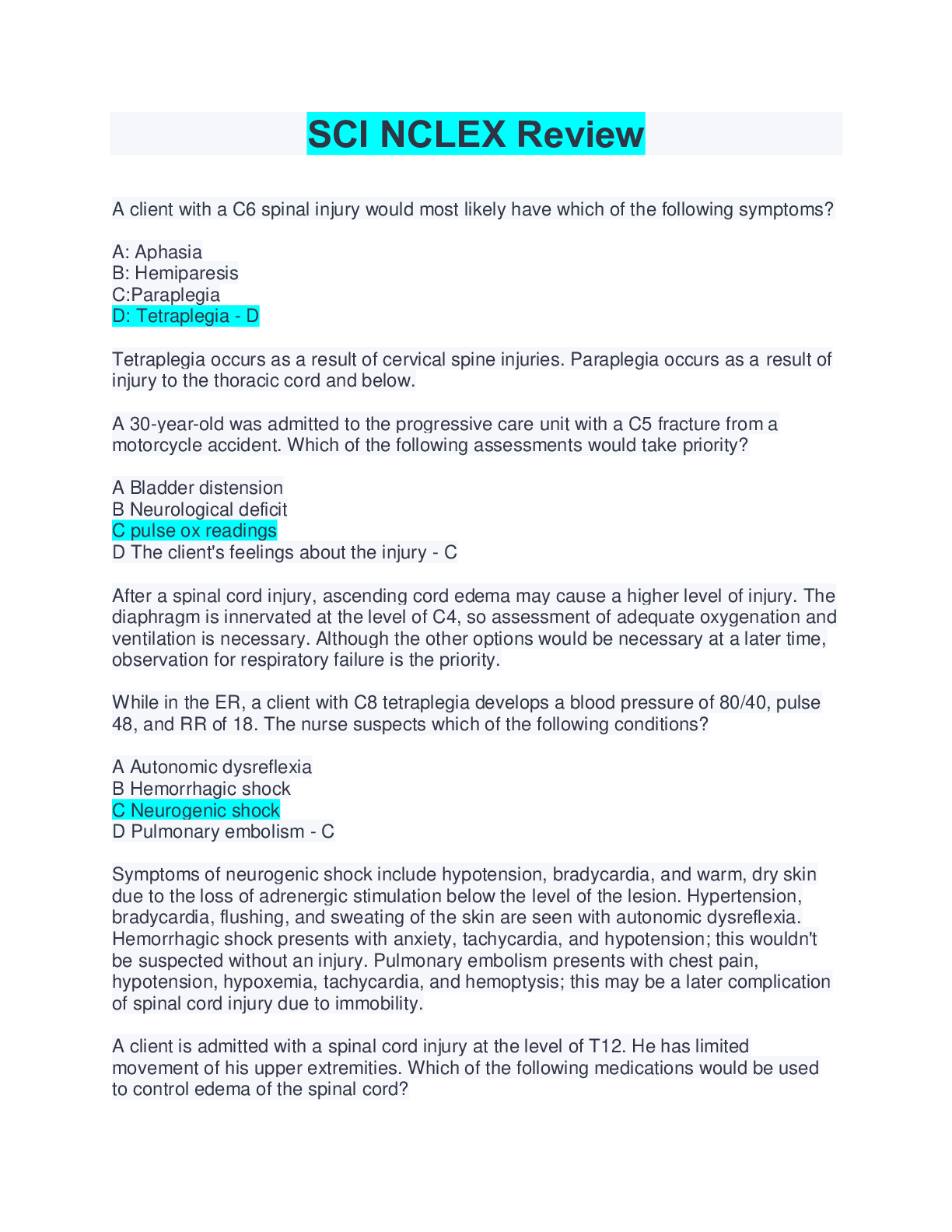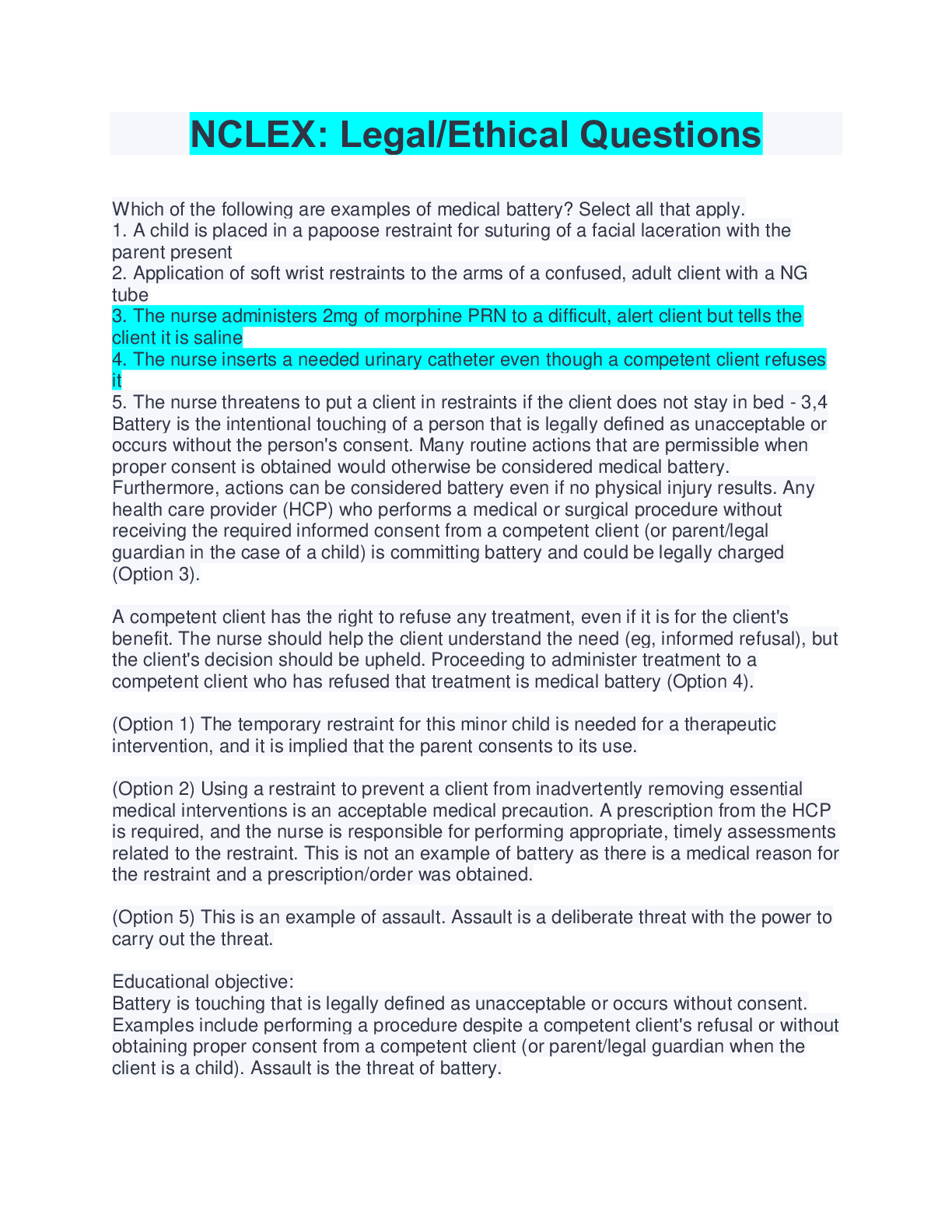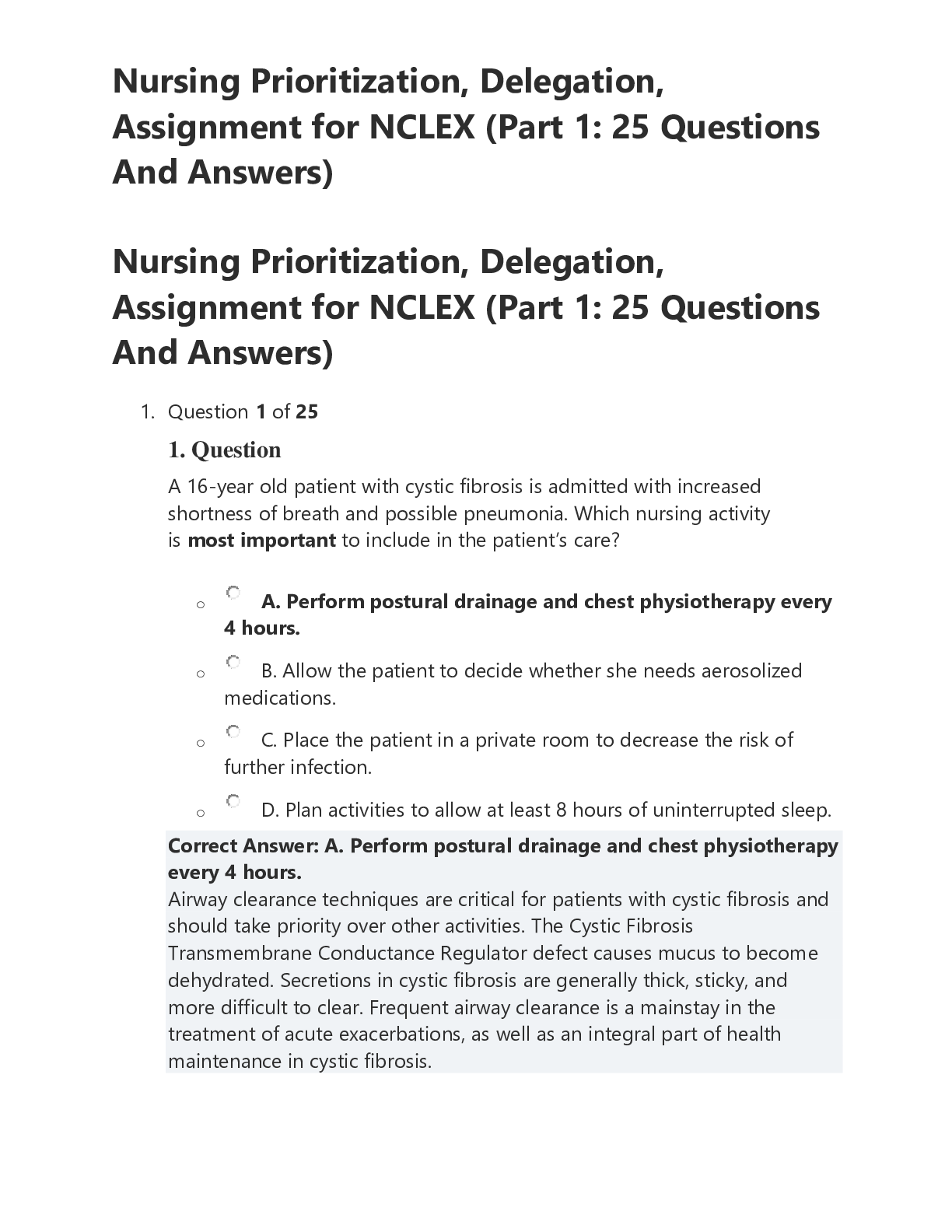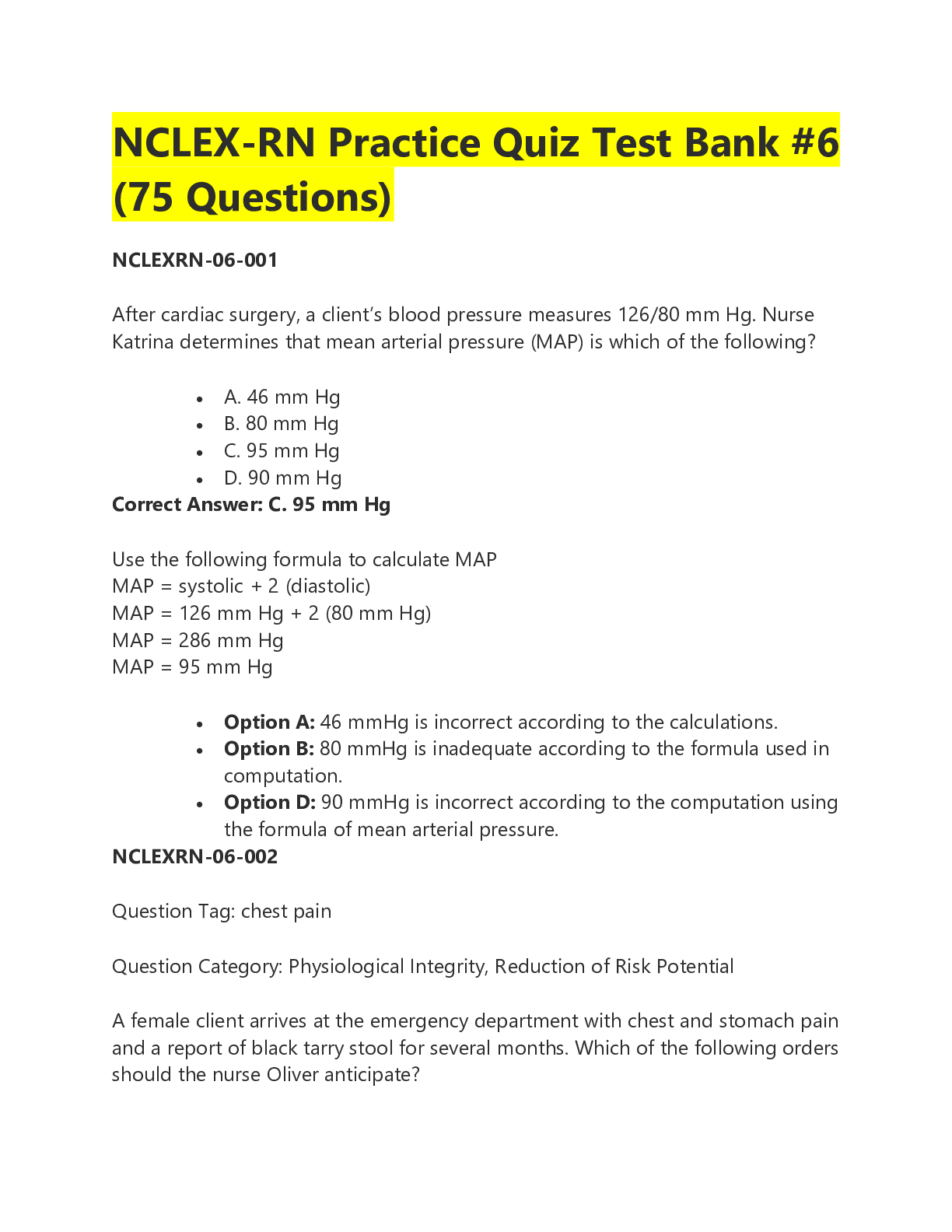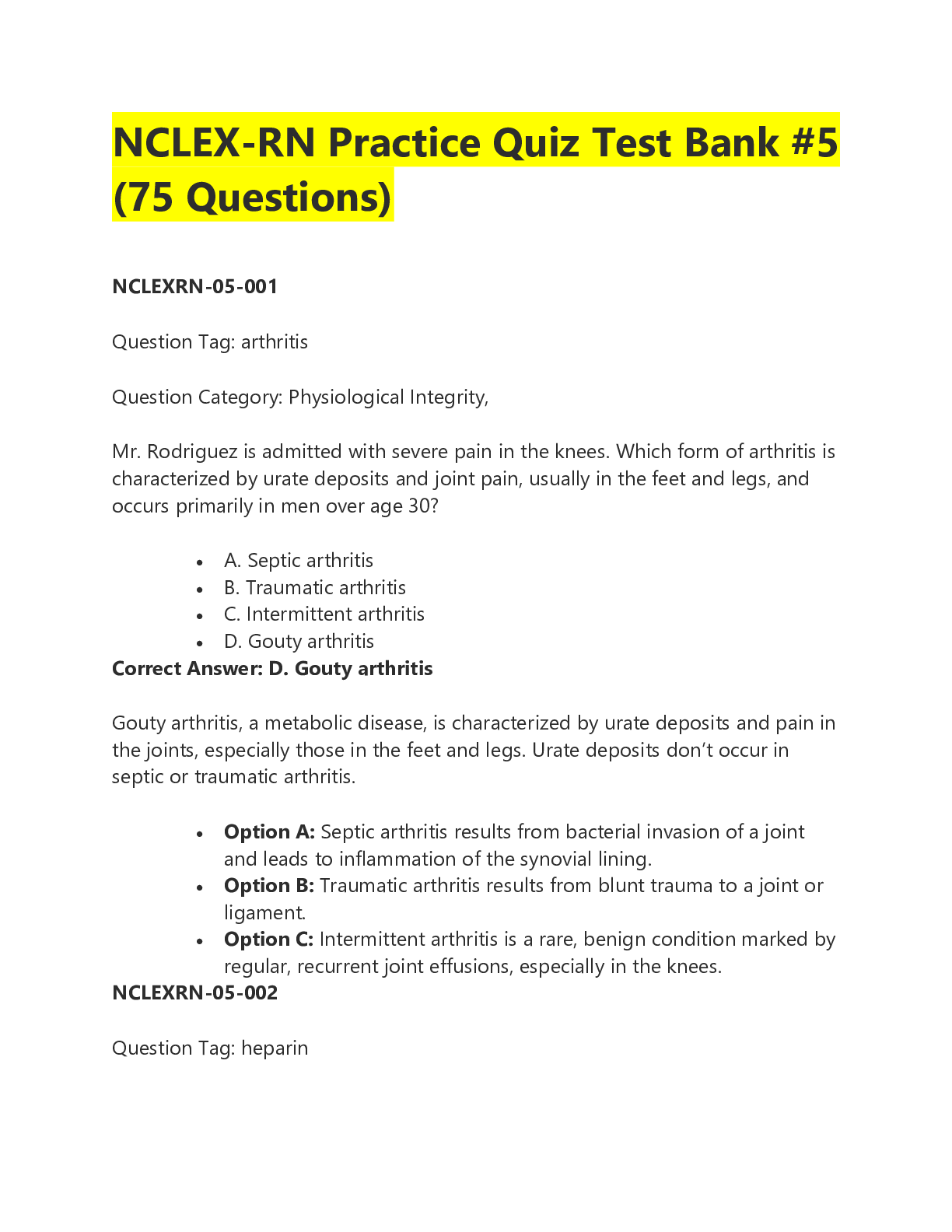*NURSING > NCLEX > Touhy & Jett: Ebersole and Hess’ Gerontological Nursing & Healthy Aging, 5th Edition/Chapter 12: E (All)
Touhy & Jett: Ebersole and Hess’ Gerontological Nursing & Healthy Aging, 5th Edition/Chapter 12: Elimination
Document Content and Description Below
Chapter 12: Elimination Touhy & Jett: Ebersole and Hess’ Gerontological Nursing & Healthy Aging, 5th Edition MULTIPLE CHOICE 1. Which of the following is a true statement about elimination... in older adults? 2. Which action should be incluNdedRin aIll bGladdBe.r-CretraMining programs? 3. The nurse understands that stress incontinence occurs 4. What is the most important aspect of care for the nurse to maintain when assisting an older patient with urinary incontinence? 5. Which option is part of a program that addresses bowel incontinence in an older adult patient? 6. An older adult who is on bed rest after surgery is prescribed morphine for pain. Which of the following is the nurse’s priority for preventive care? This older adult is at high risk for developing constipation as a result of being on bed rest and being prescribed an opiate for pain. A decrease in activity, combined with the use of an opiate, often leads to constipation, not diarrhea. Appetite can be poor for the first few days after surgery, but it often returns without incidence. Decreased fluid intake is often supplemented with intravenous fluids for the first few days after surgery. PTS: 1 DIF: Apply REF: p. 165-166 TOP: Nursing Process: Planning MSC: Health Promotion and Maintenance 7. The nurse is caring for a patient who has recently had an indwelling catheter placed. The nurse should assess the patient for a. an increase in oral fluid intake. b. a change in mental status. c. upper back pain. d. a decrease in activity. ANS: B The nurse assesses the older adult’s mental status. Changes in mental status, character of urine, decreased appetite, abdominal pain, chills, low back pain, urethral discharge in men, new onset of incontinence, or even respiratory distress may signal a possible urinary tract infection in older people. An indwelling catheter does not often cause a decrease in activity. PTS: 1 DIF: Apply REF: p. 163 TOP: Nursing Process: Assessment MSC: Physiological Integrity 8. The nurse assesses a male resident in a nursing home for urinary incontinence and determines that he is unaware of the problem. Which recommendation should the nurse implement? a. Limit oral fluid intake. NURSINGTB.COM b. Provide regular toileting. c. Apply absorbent undergarment. d. Encourage frequent rest periods. ANS: B The nurse provides regular toileting to promote voiding and to prevent incontinence for a resident with a potential cognitive impairment. The nurse avoids limiting oral fluid intake; older adults, especially those living in residential facilities, are at higher risk for dehydration than younger people. Using absorbent undergarments may be unnecessary if the incontinence can be controlled with regular toileting. Nursing research supports the claim that ambulatory residents are less likely to be incontinent. This resident may have dementia, but maintaining mobility will have a greater impact in preventing incontinence. PTS: 1 DIF: Apply REF: p. 167 TOP: Nursing Process: Planning MSC: Health Promotion and Maintenance 9. A large residual urine volume characterizes what type of incontinence? a. Urge b. Stress c. Overflow d. Functional ANS: C Dribbling, hesitancy, and a large residual urine volume characterize overflow incontinence. Both urge incontinence and stress incontinence are associated with a small residual urine volume. Functional incontinence is not associated with residual urine volume. PTS: 1 DIF: Remember REF: p. 157 TOP: Nursing Process: Assessment MSC: Physiological Integrity 10. The nurse wants to begin helping a resident who is overweight and has urinary incontinence with healthy bladder behavior skills. Which intervention should the nurse implement? a. Begin a low-calorie diet for weight management. b. Schedule voiding at 2- to 4-hour intervals. c. Instruct the resident to practice abdominal exercises. d. Reduce the time between an urge to void and voiding. ANS: B Healthy bladder behavior skills include scheduling voiding at 2- to 4-hour intervals for residents either independently or with prompting. Beginning a low-calorie diet can be a reasonable approach to urinary incontinence, but the nurse first applies low-cost behavioral techniques. Pelvic floor exercises will help control urinary incontinence. Bladder training involves increasing the time between the urge to void and voiding. PTS: 1 DIF: Apply REF: p. 158 TOP: Nursing Process: Implementation MSC: Health Promotion and Maintenance 11. An older woman tells the nurse practitioner that she fears her family will place her in a nursing home because she developed stress incontinence. Which recommendation should the nurse implement? a. Tell her to eliminate the uNsUe oRfScIafNfeGinTatBed.bCevOeMrages. b. Coordinate a family conference with the older adult. c. Recommend exercises to strengthen the pelvic floor. d. Schedule voiding for every 2 hours around the clock. ANS: C The nurse practitioner recommends pelvic floor exercises to strengthen the pelvic floor and the muscles that surround the urethra, vagina, and rectum to decrease the incidence of stress incontinence. Stress incontinence is usually caused by weakened pelvic floor muscles; therefore, eliminating caffeinated beverages can be an ineffective treatment. Arranging a family conference is premature and potentially embarrassing for older adults. Many therapies are available to decrease this older adult’s incontinence. Scheduled voiding is recommended at 2- to 4-hour intervals during the day and at 4-hour intervals at night. PTS: 1 DIF: Apply REF: p. 159 TOP: Nursing Process: Implementation MSC: Health Promotion and Maintenance 12. A nurse visits an older woman in her home. The woman was recently discharged from a subacute rehabilitation facility where she went after a left hip open reduction and internal fixation. The patient ambulates steadily and slowly with a rolling walker. The patient reports that she has an “embarrassing problem” and states that she doesn’t always make it to the bathroom and often wets herself on the way. She attributes this to the fact that she moves slowly. The patient has no complaints of burning or pain on urination. The nurse suspects which type of urinary incontinence? a. Stress b. Overflow c. Functional d. Urge ANS: C Functional incontinence is related to the inability to get to the bathroom because of mobility or environmental issues. This patient moves slower and therefore cannot get to the bathroom in time. PTS: 1 DIF: Apply REF: p. 157 TOP: Nursing Process: Assessment MSC: Health Promotion and Maintenance 13. An older woman presents to the geriatric clinic for a routine annual wellness visit. Upon assessment, the patient reports that she needs to wear a pad because she loses urine when she coughs and sneezes. She also reports that this happens when she picks up her 2-year-old grandson. The nurse suspects which type of urinary incontinence? a. Stress b. Overflow c. Functional d. Urge ANS: A Stress incontinence is defined as a loss of small amount of urine with activities that increase intra-abdominal pressure (e.g., coughing, sneezing, exercising, lifting, bending). PTS: 1 DIF: Apply REF: p. 157 TOP: Nursing Process: AssessNmUenRt SINGMTSBC.: MULTIPLE RESPONSE CHeOalMth Promotion and Maintenance 1. Long-term use of external catheters can lead to which complications? (Select all that apply.) a. Fungal skin infections b. Penile skin maceration c. Atrophy d. Edema e. Phimosis ANS: A, B, D, E Long-term use of external catheters can lead to fungal skin infections, penile skin maceration, edema, fissures, contact burns from urea, phimosis, UTIs, and septicemia. The catheter should be removed and replaced daily and the penis cleaned, dried, and aired to prevent irritation, maceration, and the development of pressure ulcers and skin breakdown. If the catheter is not sized appropriately and applied and monitored correctly, then strangulation of the penile shaft can occur. Atrophy has not been identified as a complication. PTS: 1 DIF: Remember REF: p. 162-163 TOP: Nursing Process: Assessment MSC: Health Promotion and Maintenance 2. Continuous indwelling catheter use is indicated for which conditions? (Select all that apply.) a. Urethral obstruction b. Urinary retention c. Stress incontinence d. Severely impaired skin integrity e. Gait impairment ANS: A, B, D Continuous indwelling catheter use is indicated for those with urethral obstruction or urinary retention because these patients are unable to empty their bladders without this device. Stress incontinence is not a condition that warrants a continuous indwelling catheter. Continuous indwelling catheter use is indicated for patients with severely impaired skin integrity to decrease the risk of further deterioration of skin integrity. Immobility is not an evidence-based indication for an indwelling catheter. PTS: 1 DIF: Remember REF: p. 162 TOP: Nursing Process: Assessment MSC: Health Promotion and Maintenance 3. A nurse is conducting education on urinary incontinence at a senior center. The nurse is discussing lifestyle changes that are associated with an improvement in urinary incontinence. The nurse includes which of the following interventions? (Select all that apply.) a. Weight reduction b. Smoking cessation c. Increase in physical activity d. Fluid restriction e. Blood sugar control ANS: A, B, C Several lifestyle factors have been associated with an improvement in urinary incontinence. These include increased fluidNiUntRakSe,IsNmGokTinBg.cCesOsaMtion, bowel management, physical activity, and weight reduction. Fluid restriction is not an intervention associated with an improvement in urinary incontinence, nor is blood sugar control. PTS: 1 DIF: Remember REF: p. 161 TOP: Nursing Process: Assessment MSC: Health Promotion and Maintenance 4. An older adult with moderate dementia is seen in the geriatric clinic. As the nurse is evaluating the patient, the patient’s wife states that her husband has developed an increasing number of episodes of incontinence. She does not know what is precipitating the episodes and states, “Maybe he just doesn’t remember that he needs to urinate, or maybe it’s me; it takes me a while to walk him to the bathroom.” The nurse develops a plan of care for this patient and includes which of the following interventions to manage the incontinence? (Select all that apply.) a. Use of adult incontinence briefs b. Use of an external catheter c. Development of a toileting schedule d. Use of a commode close by to where the patient spends most of his time e. Bladder diary to be completed by the patient’s wife ANS: C, D, E A bladder diary is a helpful tool used to assess an individual’s voiding patterns and to assist in assessment of incontinence. Development of a toileting schedule can be helpful in individuals with dementia who might no longer be aware of the cues to void. A commode may be helpful in this case because the wife indicates that it takes her some time to bring her husband to the toilet. Adult incontinence briefs and external catheters are not first-line interventions for this individual. PTS: 1 DIF: Analyze REF: p. 159-161 TOP: Nursing Process: Assessment MSC: Health Promotion and Maintenance NURSINGTB.COM [Show More]
Last updated: 1 year ago
Preview 1 out of 7 pages
Instant download

Buy this document to get the full access instantly
Instant Download Access after purchase
Add to cartInstant download
Reviews( 0 )
Document information
Connected school, study & course
About the document
Uploaded On
Aug 08, 2021
Number of pages
7
Written in
Additional information
This document has been written for:
Uploaded
Aug 08, 2021
Downloads
0
Views
58


